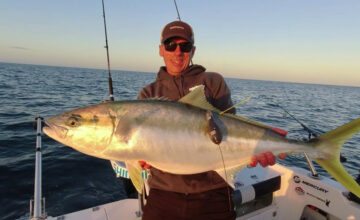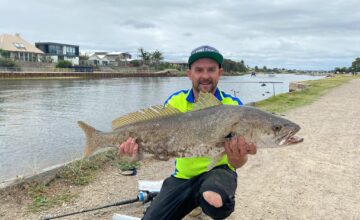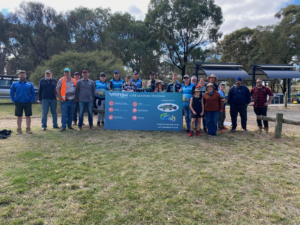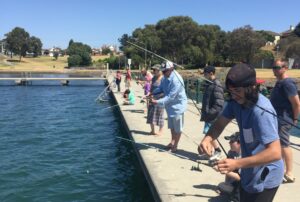August 27, 2019
Written by Greg Jenkins
Anglers participating in the Victorian King George Whiting tagging project have tagged a massive 684 Whiting over the course of the project so far! The latest project update was released on 27 August 2019.
This project works through the involvement of recreational fishers and is supported by the Recreational Fishing Licence Funding Program. The project has been running since January 2017 and works in partnership with fishing clubs as well as individual anglers.
The project seeks to unlock some of the still unknown secrets about the life of King George Whiting in Victoria. We know that Whiting enter our major bays when they are only a few months old and then leave again at about 4 years of age when they are about to mature and begin spawning. We also know that at the known offshore spawning grounds in South Australia and Tasmania, fish up to 20 years old and over 70 cm in length can be found. But, we don’t know how much juvenile (up to 4 years old) Whiting move within bays or between bays. And we also don’t know where our older Whiting go once they leave the bays, including where they spawn.
Fish tagging
So far in the project 684 Whiting have been tagged, and these have nearly all come from five main areas (Figure 1); Southern Bellarine (Queenscliff to St Leonards) and Geelong Arm (Clifton Springs to Point Henry) in Port Phillip; and, Tortoise Head, Middle Spit and Somers in Western Port. The area with the most fish tagged is the Geelong Arm.
Figure 1. Main areas for King George Whiting tagging in Port Phillip Bay and Western Port.
Tagged Whiting have ranged in size from 20 cm to 48 cm (Figure 1). Good numbers of large (38 cm +) Whiting were tagged early in the project, mostly in the Queenscliff and Somers areas (Figure 1). More recently the tagged fish have tended to be smaller, reflecting the entry of the strong 2016 year-class into the fishery. These smaller fish around or under legal size have mostly been tagged in the Geelong Arm area (Figure 1). Recently good numbers of moderately sized Whiting have also been tagged in the Tortoise Head area of Western Port.
Figure 1. Number and size of King George Whiting tagged in five areas between January 2017 and August 2019.
Peter Kellam of the Bellarine Pirates and St Leonards Angling Club is our top tagger so far, accounting for nearly half of all tagged fish! Chris Garner of the Western Port Angling Club is the top tagger in Western Port. Don Newman, also of Western Port Angling Club, has the honour of tagging the largest Whiting so far (48 cm!). Along with Gordon Robinson, these top four taggers have tagged 83% of the fish so far – great effort!
Recaptures
There have been 39 recaptures of tagged whiting, giving a comparatively high return rate of 6% so far. The longest time between tagging and recapture so far has been 16 months, and the shortest is 45 minutes! The fish at liberty for 16 months also showed the most growth from 33 to 44 cm. A number of fish were recaptured within 40 days of tagging, and then there was a relatively even distribution of recaptures up to 12 months after tagging (Figure 2). Surprisingly, most of the fish have been recaptured close to the location where they were tagged, even after 16 months, indicating that many of the Whiting in the bays are either site attached (stay in the same spot!), or possibly move and then return to the same location on a frequent basis.
There have been some exceptions where Whiting have shown significant movement between tagging and recapture. Two fish moved approximately 30 km from Clifton Springs to Werribee South in Port Phillip Bay over a 5-month period (2-3 cm growth). In Western Port a tagged Whiting moved 20 km from Somers to Dickies Bay (San Remo) over 11 months (5 cm growth from 35 cm to 40 cm). Another of the recaptured fish in Western Port showed the greatest short-term movement recorded so far, from Somers to Middle Spit in Western Port (over a 3-week period), a distance of approximately 24 km.
Peter Kellam is our leader in the number of fish tagged that have been recaptured, while Don Newman is the leader in the number of fish recaptured!
Figure 2. Number of days between tagging and recapture for King George Whiting tagged between January 2017 and August 2019.
There has been no evidence of Whiting moving between bays or offshore so far. Fishers are still catching some large (40 cm +) whiting, but they are harder to find this year, most likely because some have now moved out onto the coast. As this movement offshore happens we are hopeful of receiving some recaptures from further afield in the near future.
Please be on the lookout for tagged whiting
If you capture a Whiting with one of the yellow tags, please contact us on 03 52583686, or email [email protected], and provide the tag number, as well as the length of the fish, date and location of capture. If desired, the fish can be released again to provide even more information for the project.
Fishers are reporting that the Whiting fishing has been very good this year, particularly for smaller fish, which is consistent with our predictions based on the number baby whiting (larvae – see picture) that the Victorian Fisheries Authority have monitored in the past few years. The large fish tagged at the start of the project were spawned in 2013, which was a strong year for numbers of larvae. These fish are now 5 to 6 years old and are likely to have left the bays. Fortunately, 2016 was a strong year for larvae, and these are the fish that have been supporting the very good fishing for smaller fish this year. Some fishers have reported this year has been their best Whiting fishing ever! The number of larvae in 2017 and 2018 was also strong, so we expect the excellent Whiting fishing to continue once these two groups of fish enter the fishery over the next few years.
Acknowledgements
We are most grateful to the anglers who have embraced this project and the fantastic contribution they are making to the project’s success.
We thank Lauren Veale of the Nature Glenelg Trust for letting us use her newsletter on Mulloway tagging as a template for this one.
We thank VRFish and the Victorian Fisheries Authority for their ongoing support for the project.
For any enquiries on the project please contact Greg Jenkins on 52583686 or email [email protected], further information on the project can be found at: http://blogs.unimelb.edu.au/fisheries-ecology/king-george-whiting-tagging-project/







